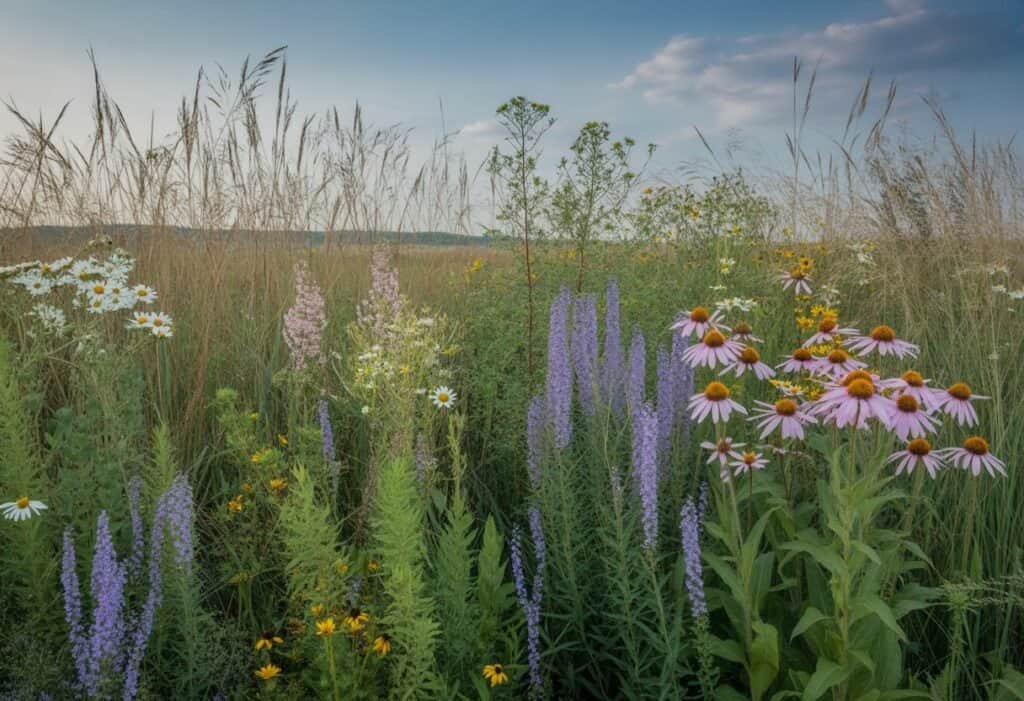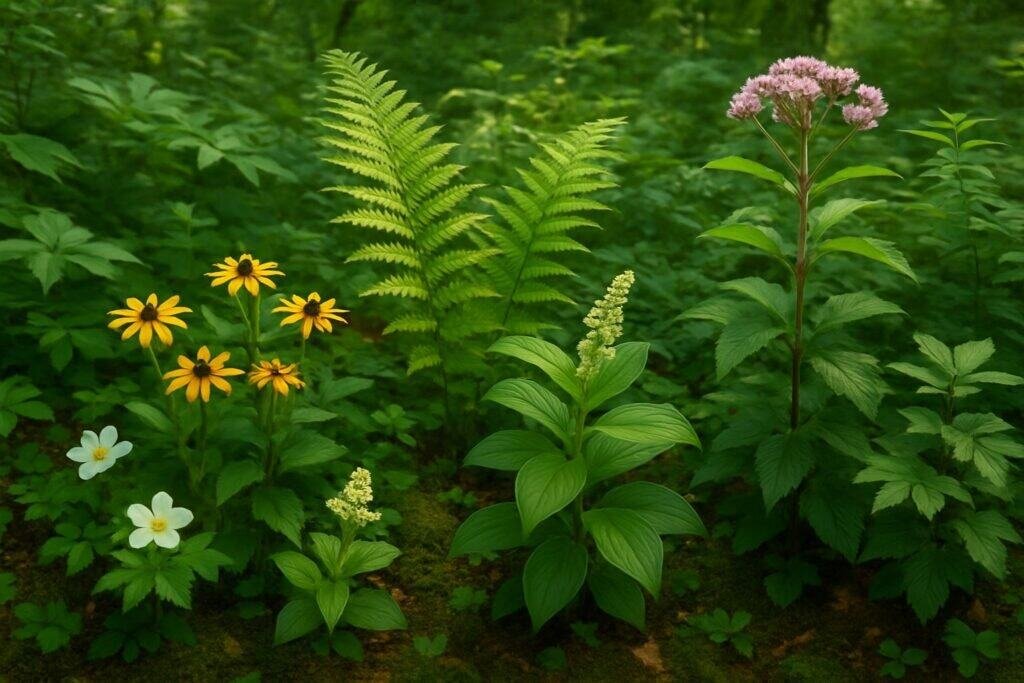Iowa’s native plants shape the state’s natural heritage. These plants evolved in local soils and climate for thousands of years, creating unique ecosystems.
Growing native plants in your Iowa garden supports local wildlife, conserves water, and helps preserve our state’s natural beauty.
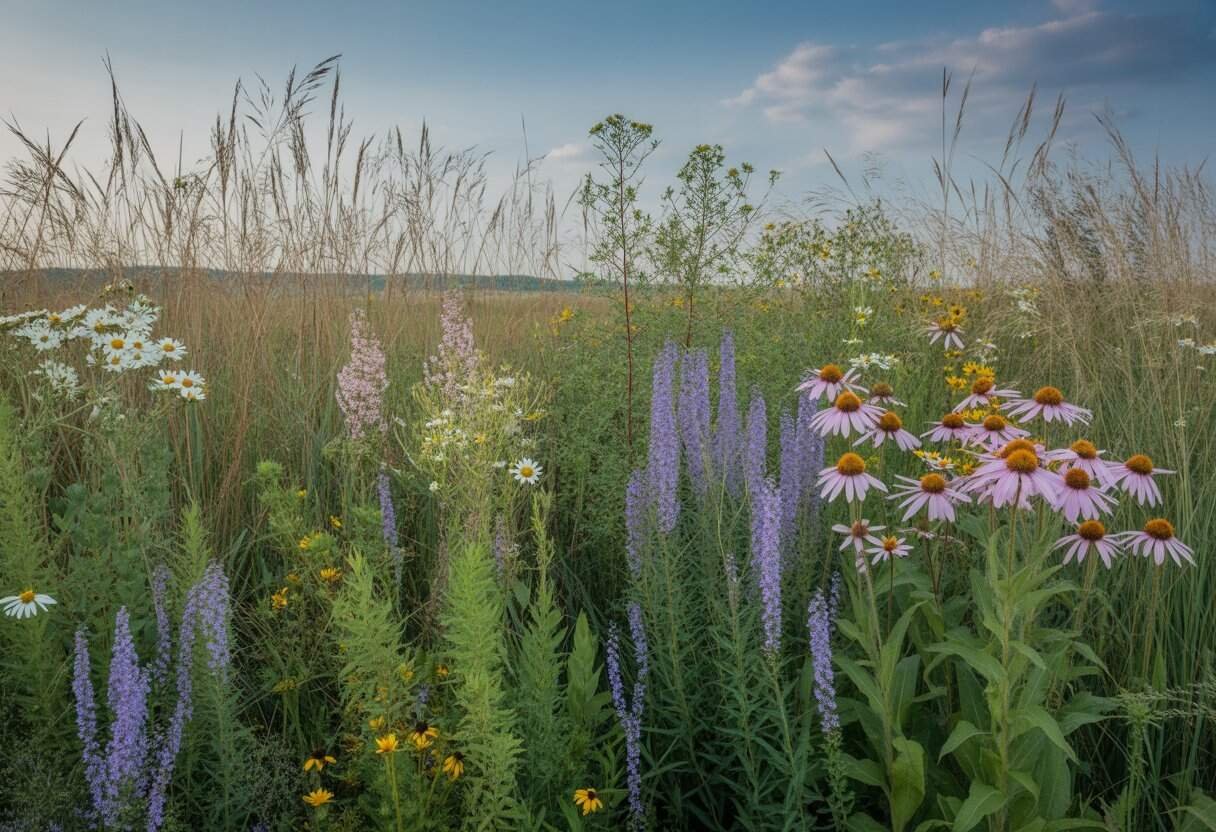
Native plants thrive in Iowa’s varied landscape. Prairie grasslands, woodland areas, and wetlands all support different species.
The deep roots of prairie plants like purple coneflower and big bluestem grass prevent soil erosion. Woodland natives such as wild ginger and Virginia bluebells bring color to shady spots in spring.
Iowa has lost much of its original prairie habitat. Home gardens with native plants have become increasingly important.
Even small native plant gardens create stepping stones for pollinators and birds. These plants require less maintenance than non-natives once established.
Key Takeaways
- Iowa native plants support local wildlife and pollinators while requiring less water and maintenance than non-native species.
- Native plant communities help prevent soil erosion, filter water, and restore ecological balance to Iowa’s landscape.
- Home gardens with native species preserve Iowa’s natural heritage and create vital habitat connections across the state.
Understanding Iowa Native Plants
Iowa’s landscape once featured plants that evolved in this region over thousands of years. These native plants are perfectly adapted to local conditions and play crucial roles in supporting wildlife.
Definition and Characteristics
Native plants are species that occurred naturally in Iowa before European settlement. These plants evolved alongside local wildlife and adapted to Iowa’s specific climate, soil, and seasonal patterns.
Native Iowa plants usually have deep root systems that help them survive drought. Prairie grasses like big bluestem can grow roots 15 feet deep.
This adaptation allows them to access water and nutrients that shallow-rooted plants cannot reach. Most native plants need less maintenance once established.
They generally don’t need fertilizers, pesticides, or frequent watering. This makes them environmentally friendly and cost-effective.
Native plants show remarkable diversity in form. The delicate purple coneflower and the majestic bur oak are two examples.
Each species has unique traits that help it thrive in specific Iowa habitats.
Ecological Importance
Native plants form the foundation of Iowa’s food webs. They provide habitat and food for wildlife, including pollinators like bees and butterflies.
Many native insects feed only on specific native plants. Monarch butterfly caterpillars, for example, eat only milkweed.
Without these plants, specialized species like monarchs cannot survive. Native plant communities also prevent soil erosion with their extensive roots.
Prairie plants hold soil in place during heavy rains. These plants improve water quality by filtering runoff before it reaches streams and rivers.
Their deep roots create channels in the soil that increase water absorption and reduce flooding. Native plantings also store carbon in their tissues and in the soil.
Native Species Versus Non-Native Species
Native species evolved in Iowa’s ecosystems over thousands of years. Non-native plants were introduced from other regions or countries.
Non-native plants often lack natural predators or diseases that control their growth. Some become invasive, outcompeting native species and reducing biodiversity.
Examples include reed canary grass and garlic mustard. Native plants support far more wildlife than non-natives.
Research shows native oak trees support over 500 species of caterpillars, while non-native ginkgo trees support almost none. Using native plants in landscaping creates “ecological corridors” that connect fragmented habitats.
These corridors allow wildlife to move between natural areas that might otherwise be isolated. Many non-native ornamentals need extra water and fertilizer, making them less sustainable for Iowa gardens.
Major Natural Habitats of Iowa
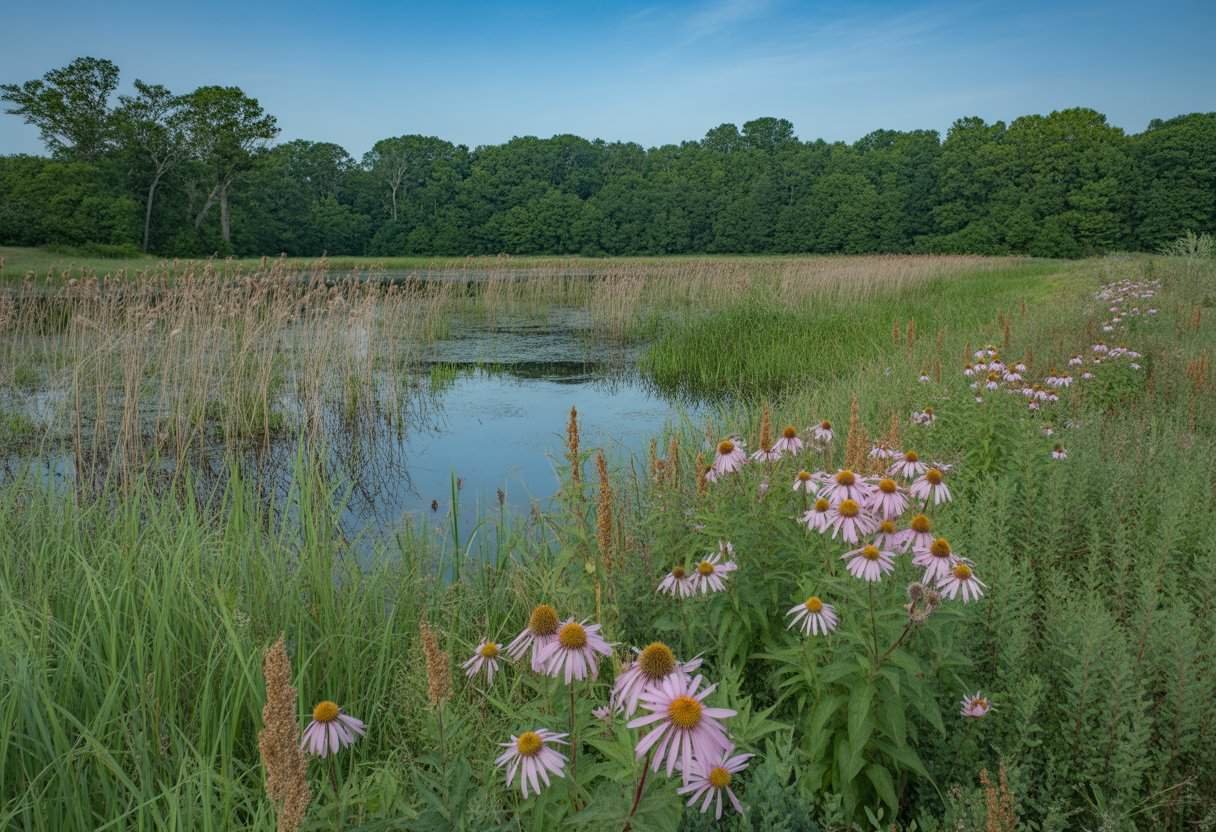
Iowa’s landscape features diverse ecosystems that support many native plant species. These natural habitats have shaped the state’s ecological identity.
Tallgrass Prairie
Tallgrass prairie once covered about 85% of Iowa’s landscape. This ecosystem features grasses that can grow up to 6 feet tall, including big bluestem, Indian grass, and switchgrass.
The deep root systems of prairie plants—sometimes reaching 15 feet deep—help build rich soil and prevent erosion. These roots also store carbon and filter water.
Native prairie wildflowers like purple coneflower, butterfly milkweed, and compass plant add vibrant colors throughout the season. They provide food for pollinators and wildlife.
The Tallgrass Prairie Center at the University of Northern Iowa works to restore these vital ecosystems. Today, less than 0.1% of Iowa’s original prairie remains.
Woodlands
Iowa’s woodlands exist mainly along river valleys and in the eastern part of the state. Oak-hickory forests dominate, with species like white oak, red oak, shagbark hickory, and black walnut.
Spring wildflowers bloom in these woods before tree leaves fully develop. Bloodroot, wild geranium, and trillium create a colorful display from April to June.
Woodland habitats provide shelter for wildlife and help prevent soil erosion along slopes and waterways. The dappled shade supports plants that can’t survive in full sun.
Iowa has lost much woodland acreage to agriculture and development. Conservation efforts focus on protecting remaining forests and managing invasive species like garlic mustard and honeysuckle.
Savannas
Savannas are transition zones between prairies and woodlands. These habitats feature scattered oak trees—mainly bur oak—with prairie plants growing beneath them.
Fire played a crucial role in maintaining savannas. Regular burns prevented dense tree growth and allowed fire-resistant oaks to thrive.
The filtered sunlight in savannas creates ideal conditions for plants like wild lupine, New Jersey tea, and bottle gentian. These species need more light than woodlands but less than open prairies.
Most of Iowa’s savannas have disappeared due to fire suppression and land conversion. Restoration efforts include controlled burns and selective tree thinning.
Wetlands
Wetlands include marshes, fens, and riparian areas where water saturates the soil. Before European settlement, wetlands covered about 4 million acres of Iowa.
Now, over 95% of wetlands have been lost. These habitats support unique plant communities, including sedges, rushes, and cattails.
Rare species like marsh marigold and swamp milkweed depend on these moist conditions. Wetlands filter pollutants, reduce flood damage, and recharge groundwater.
They also provide breeding grounds for amphibians and waterfowl. The Iowa Wetland Management District works to protect and restore these habitats.
Even small wetland areas can improve water quality and wildlife habitat in agricultural landscapes.
Iconic Iowa Native Flowers
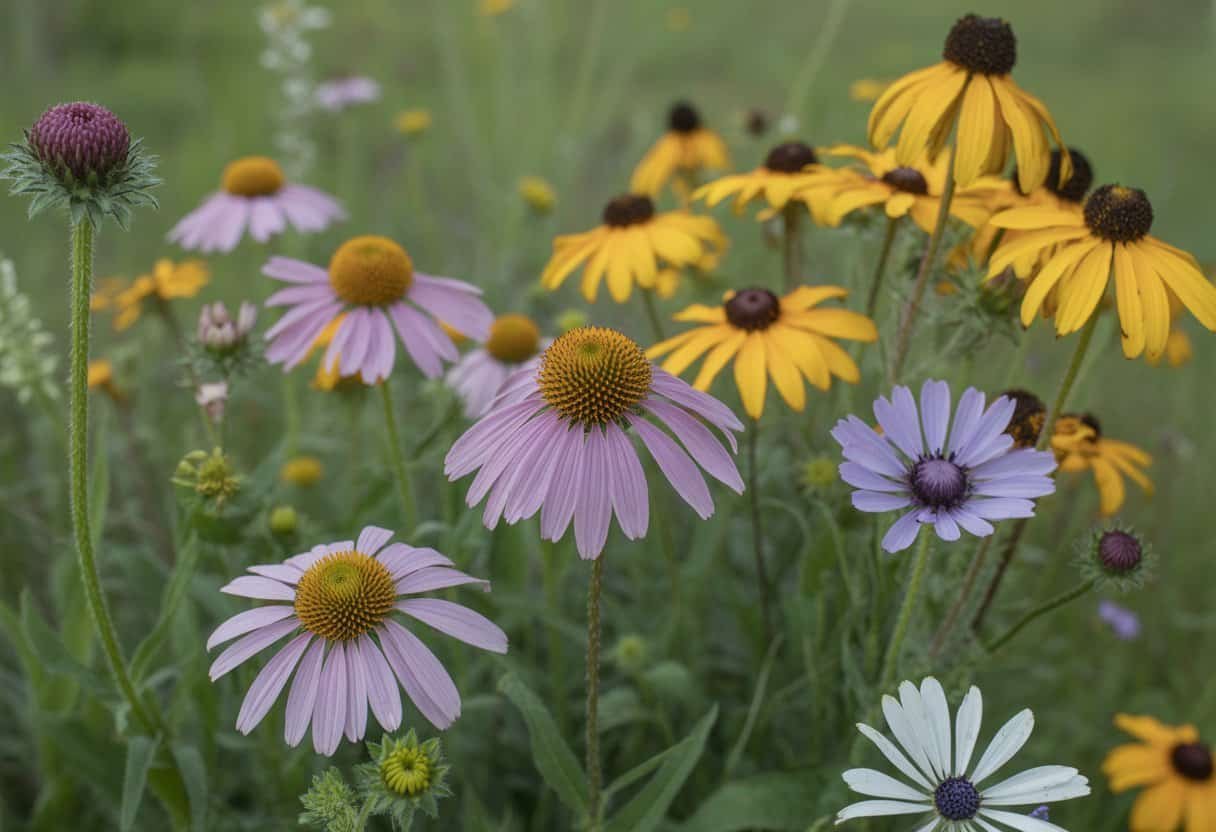
Iowa’s landscape features several beautiful native flowers that have adapted to the state’s climate and soils. These plants add color and provide habitat for local wildlife.
Purple Coneflower (Echinacea purpurea)
Purple Coneflower stands out with its purple-pink petals and spiky center. This perennial grows 2-5 feet tall and blooms from June to August.
Native to eastern and central North America, Purple Coneflower thrives in Iowa’s climate. It prefers full sun but tolerates partial shade and adapts to many soil types.
Its nectar attracts butterflies, bees, and other pollinators. Birds, especially goldfinches, eat its seeds in fall and winter.
Purple Coneflower also has medicinal uses. Native Americans used it for centuries, and people still use Echinacea to boost immunity.
Butterfly Milkweed
Butterfly Milkweed displays bright orange flowers from June through August. Unlike other milkweeds, it does not produce milky sap when stems break.
This drought-tolerant plant grows 1-2 feet tall and thrives in well-drained soils and full sun. Its bright flowers make it a standout in any garden.
Butterfly Milkweed is a crucial host plant for Monarch butterflies. Monarch caterpillars feed only on milkweed species.
The plant also attracts bees, wasps, and other butterflies. Its deep taproot makes it hard to transplant but helps it survive dry conditions.
New England Aster
New England Aster brings late-season color with purple to pink daisy-like flowers. It blooms from August through October, providing nectar when few other flowers do.
This native perennial can reach 3-6 feet tall and grows in moist meadows and along stream banks.
Pollinators rely on New England Aster’s late blooms. Butterflies, especially Painted Ladies and Monarchs, depend on its nectar during migration.
Gardeners value this plant for its fall color and low maintenance. Cutting stems back by half in early summer keeps plants shorter.
Prairie Lily
Prairie Lily, or Wood Lily, displays orange-red flowers with spotted centers from June to July. This rare native grows 1-3 feet tall and prefers partial shade.
Unlike many garden lilies, Prairie Lily evolved in Iowa’s environment and needs no special care once established. Its blooms stand on single stems with whorled leaves.
Prairie Lily populations have declined due to habitat loss and over-collection. Conservation efforts aim to protect remaining stands and restore habitat.
Prairie Lily grows slowly but can live many years once established. It grows best in slightly acidic, well-drained soil with moderate moisture.
Diverse Species and Their Growing Conditions
Iowa’s native plant landscape features a rich variety of species adapted to different conditions. These plants have evolved to thrive in specific light, soil, and moisture levels.
Full Sun Species
Blue false indigo (Baptisia australis) thrives in sunny prairies, reaching 3-4 feet tall with blue-purple flowers in late spring. This drought-tolerant plant prefers well-drained soil and needs little care once established.
Yarrow (Achillea millefolium) displays flat-topped white flower clusters that attract pollinators all summer. It grows 1-3 feet tall and handles poor soils and dry conditions, making it ideal for sunny borders.
Golden Alexanders (Zizia aurea) produces bright yellow flowers in spring. This 1-2 foot tall plant prefers slightly moist soil but tolerates drought once established.
Mountain mint (Pycnanthemum virginianum) features clusters of tiny white flowers with purple spots that attract many pollinators. It grows 2-3 feet tall in full sun and has aromatic foliage that deer avoid.
Partial Shade and Woodland Species
Wild Columbine (Aquilegia canadensis) displays distinctive red and yellow nodding flowers in spring. This 1-2 foot plant thrives in dappled light and well-drained soil.
You often find Wild Columbine along woodland edges.
Wild Bergamot (Monarda fistulosa) produces lavender flower heads that attract bees and butterflies. It grows 2-4 feet tall and adapts to partial shade.
Wild Bergamot flowers most abundantly with at least 4 hours of sun.
Wild Ginger (Asarum canadense) forms a low groundcover with heart-shaped leaves. Its unusual brownish-purple flowers appear at soil level in spring.
This woodland plant spreads slowly and prefers rich, moist soil.
Jacob’s Ladder (Polemonium reptans) features delicate blue-purple flowers above fern-like foliage. Growing 12-18 inches tall, it blooms in spring.
Jacob’s Ladder prefers rich, well-drained woodland soil.
Wetland and Aquatic Species
Blue Flag Iris (Iris versicolor) displays showy violet-blue flowers in late spring. This 2-3 foot tall plant thrives in consistently wet soil along pond edges and stream banks.
Water Lily (Nymphaea odorata) produces fragrant white flowers that float on water surfaces. Its round leaves provide shade for aquatic wildlife and habitat for fish.
Water Lily grows best in still water 1-6 feet deep.
American Lotus (Nelumbo lutea) features dramatic yellow flowers held above the water on tall stalks. Its distinctive round leaves can reach 2 feet in diameter.
American Lotus grows in shallow waters and muddy pond bottoms.
Monkey Flower (Mimulus ringens) displays snapdragon-like lavender flowers in summer. This 1-3 foot plant thrives in consistently moist soil and can handle periodic flooding.
Monkey Flower works well in rain gardens and wetland edges.
Wildlife and Ecological Benefits
Iowa native plants form the foundation of local ecosystems. They provide essential resources for wildlife and contribute to ecological balance.
Pollinators and Beneficial Insects
Native plants support diverse pollinator populations. Monarch butterflies depend on milkweed species to complete their life cycle.
Monarchs lay eggs exclusively on milkweed plants. The caterpillars feed on milkweed leaves before transforming into butterflies.
Bees, including Iowa’s 200+ native bee species, collect nectar and pollen from plants like purple coneflower, wild bergamot, and goldenrod. These plants produce more nutritious pollen than many non-natives.
Beneficial insects such as ladybugs, lacewings, and predatory wasps use native plants for shelter and hunting grounds. These insects help control garden pests naturally.
Key Iowa Plants for Pollinators:
- Butterfly milkweed
- New England aster
- Wild bergamot
- Prairie blazing star
- Pale purple coneflower
Habitat for Birds and Mammals
Native plants provide food and shelter for Iowa wildlife throughout the seasons. Birds rely on native berries, seeds, and the insects that native plants attract.
Cardinal flower and trumpet honeysuckle offer nectar for hummingbirds. Serviceberry and elderberry produce fruits eaten by songbirds and small mammals.
The dense structure of native grasses creates cover for ground-nesting birds and small mammals.
In winter, seed heads from coneflowers, black-eyed Susans, and native grasses feed birds when food is scarce. These plants remain standing through snow.
Native oaks support over 500 species of caterpillars. Nesting birds rely on these caterpillars to feed their young.
A single chickadee pair needs 6,000-9,000 caterpillars to raise one brood.
Gardening with Iowa Native Plants
Native plants bring natural beauty to Iowa gardens while supporting local ecosystems. These plants evolved in Iowa’s climate and soil conditions.
Selecting Native Plants for Your Landscape
Start by assessing your garden’s conditions. Note the sunlight exposure, soil type, and moisture levels in different areas.
This information will help you match plants to the right spots.
For sunny areas, consider purple coneflower, butterfly milkweed, and black-eyed Susan. These colorful native flowers thrive in full sun and well-drained soil.
Shade gardens benefit from wild ginger, woodland phlox, and Jacob’s ladder. These plants naturally grow in Iowa’s woodland understories.
For wet areas, choose swamp milkweed, blue flag iris, or cardinal flower. These natives handle periodic flooding well.
When purchasing plants, seek out local nurseries specializing in Iowa native plants. They often provide plants grown from local seed sources.
Care and Maintenance
Native plants require less maintenance than exotic species once established. During the first year, water regularly to help roots develop.
After establishment, most natives need minimal watering except during severe drought.
Avoid fertilizers in most cases. Iowa natives evolved in local soils and rarely need supplements.
Too much fertilizer can reduce flowering and make plants leggy.
Mulch with 2-3 inches of shredded leaves or wood chips to retain moisture and suppress weeds. Leave some bare soil for ground-nesting bees.
Leave seed heads and stalks standing through winter. They provide food for birds and shelter for beneficial insects.
Cut back dead growth in early spring before new growth emerges.
Disease problems rarely occur with natives when planted in appropriate conditions. Their natural resistance reduces the need for pesticides.
Attracting Wildlife and Pollinators
Native plants form the foundation of Iowa’s food web. Each native plant species supports specific wildlife.
Plant milkweed varieties to support monarch butterflies. Their caterpillars feed exclusively on milkweed leaves.
Adult monarchs and other butterflies need nectar-rich flowers like blazing star and Joe-Pye weed.
Native bees benefit from early spring bloomers like wild geranium and late-season flowers such as asters and goldenrod. These provide pollen and nectar when other food sources are scarce.
Birds flock to gardens with native berries and seeds. Serviceberry trees offer spring berries while coneflowers and sunflowers provide seeds in fall and winter.
Create habitat layers by combining ground covers, perennials, shrubs, and trees. This diversity provides multiple feeding and nesting opportunities for wildlife.
Conservation and Community Involvement
Protecting Iowa’s native plants requires effort from individuals, organizations, and government agencies. Collaborative initiatives help preserve Iowa’s natural heritage and create opportunities for public education.
Preserving Local Ecosystems
Iowa’s native ecosystems face challenges from agricultural expansion, urban development, and invasive species. Conservation efforts focus on protecting remaining prairie patches, woodland areas, and wetlands.
The Iowa Department of Natural Resources manages over 400,000 acres of public lands that serve as refuges for native plant species. These protected areas help maintain biodiversity within plant populations.
Private landowners play a crucial role. Many participate in programs like the Conservation Reserve Program (CRP), which provides financial incentives to restore native vegetation.
County conservation boards acquire and manage natural areas. They often restore degraded lands by removing invasive species and replanting native species.
Role of Iowa Native Plant Society
The Iowa Native Plant Society (INPS) connects plant enthusiasts, conservation professionals, and scientists. Founded in 1995, this non-profit promotes awareness and appreciation of Iowa’s native flora.
INPS coordinates volunteer workdays where members remove invasive species, collect seeds, and plant natives in public spaces. These activities contribute directly to conservation and build community.
The society publishes quarterly newsletters featuring:
- Research updates on native plant conservation
- Profiles of threatened species
- Tips for growing natives in home landscapes
- Upcoming events and volunteer opportunities
INPS also advocates for native plant protection at the policy level. They work with lawmakers to strengthen protections for rare species and their habitats.
Educational Opportunities and Field Trips
Learning about native plants firsthand helps people understand their importance. Conservation groups organize field trips to provide these experiences.
The Iowa Native Plant Society hosts guided walks during spring, summer, and fall. These excursions visit different ecosystems across the state.
County conservation boards offer programs for all ages. Naturalists lead plant identification walks and workshops on prairie restoration and native gardening.
University extension offices provide educational resources and training for landowners interested in incorporating natives.
Citizen science programs engage volunteers in monitoring rare plant populations. Participants collect valuable data and develop deeper connections to Iowa’s natural heritage.
Noteworthy Iowa Trees and Structural Plants
Iowa’s landscape features many remarkable native trees and structural plants. These plants provide habitat for wildlife and beauty to the environment.
The Bur Oak (Quercus macrocarpa) stands as one of Iowa’s most impressive native trees. These massive oaks can live for 200-300 years and reach heights of 80 feet.
Their distinctive fringed acorns and deeply ridged bark make them easy to identify. Bur Oaks develop thick, fire-resistant bark that helped them survive prairie fires.
This adaptation allowed them to thrive when other trees could not. Bur Oaks helped create the oak savannas that once covered parts of the state.
The Eastern Red Cedar (Juniperus virginiana) represents another important Iowa native. This evergreen provides winter shelter for birds and small mammals.
Its blue berries serve as food for many bird species during cold months.
Basswood trees (Tilia americana) grow throughout Iowa’s woodlands. Their fragrant flowers attract bees and other pollinators.
Basswood trees are valuable for honey production.
The Kentucky Coffeetree (Gymnocladus dioicus) features unique compound leaves and large seed pods. These striking trees add diversity to Iowa’s forests.
Other notable native trees include:
- Black Walnut
- Shagbark Hickory
- American Elm
- River Birch
- Hackberry
These native trees provide ecosystem services including erosion control, air purification, and wildlife habitat.
Frequently Asked Questions
Iowa native plants bring beauty and ecological benefits to gardens and landscapes. They support local wildlife and typically require less maintenance than non-native species once established.
Which native Iowa plants are most suitable for home landscaping?
Prairie Dropseed and Little Bluestem are excellent native grasses for home landscapes. They provide year-round interest with summer growth and golden fall colors.
Purple Coneflower thrives in sunny spots and attracts butterflies and birds. This drought-resistant perennial produces striking purple blooms from June through August.
Wild Geranium works well in partially shaded areas. Its delicate pink-purple flowers appear in spring.
Wild Geranium foliage offers attractive fall color.
New Jersey Tea forms a compact shrub ideal for borders. It produces white flower clusters that attract pollinators and tolerates poor soil conditions.
What are the most common native flowers found in Iowa?
Black-Eyed Susan displays bright yellow petals with dark centers from June to September. These hardy plants naturalize easily in prairie-like settings.
Butterfly Milkweed produces vibrant orange flower clusters that serve as crucial monarch butterfly habitat. It blooms from June through August.
Wild Bergamot (Bee Balm) features lavender flowers that attract bees and butterflies. This aromatic plant thrives in most soil conditions.
Prairie Blazing Star sends up tall purple spikes in mid to late summer. These distinctive flowers attract numerous pollinators and provide vertical interest.
How can one identify various Iowa native plants?
Leaf arrangement and shape provide key identification clues. Note whether leaves grow opposite each other or alternately along stems.
Flower structure and color help distinguish similar species. Count petals and observe their arrangement to narrow down plant families.
Growth habit—whether plants form clumps, spread by runners, or grow as single stems—can help with identification.
Field guides specific to Midwest or Iowa flora offer detailed descriptions and images. The Iowa Department of Natural Resources website provides free identification resources.
Can you list some native trees that are indigenous to Iowa?
Bur Oak reaches impressive sizes with distinctive lobed leaves and large acorns. These long-lived trees support numerous wildlife species.
Red Maple provides brilliant fall color and adapts to various soil conditions. Its early spring flowers support pollinators.
Eastern Redbud offers pink-purple blooms in early spring before leaves appear. This understory tree works well in smaller landscapes.
River Birch features attractive peeling bark and thrives in moist areas. Its multi-trunked form adds winter interest to landscapes.
What are some native plants recommended for outdoor spaces in Iowa?
For rain gardens, Blue Flag Iris and Fox Sedge manage water effectively. They absorb excess moisture while providing habitat value.
Sunny borders benefit from Pale Purple Coneflower and Prairie Coreopsis. These drought-resistant plants provide summer-long color.
Woodland gardens thrive with Virginia Bluebells and Wild Columbine. These spring bloomers perform well in dappled shade.
For challenging slopes, Prairie Smoke and Side-Oats Grama prevent erosion. Their root systems stabilize soil effectively.
Where can one purchase native Iowa plants for gardening purposes?
Local nurseries specializing in native plants offer the best selection. Ion Exchange and Prairie Moon Nursery carry many Iowa native plants.
County conservation board plant sales happen every spring. These events offer affordable native plants grown locally.
Native plant societies host member plant exchanges. The Iowa Native Plant Society keeps a calendar of these events.
You can also order plants by mail from Prairie Nursery and Missouri Wildflowers Nursery. These companies ship bare-root plants during the planting season.

